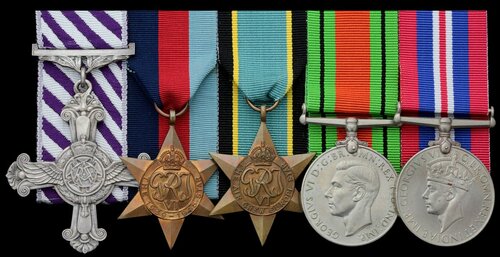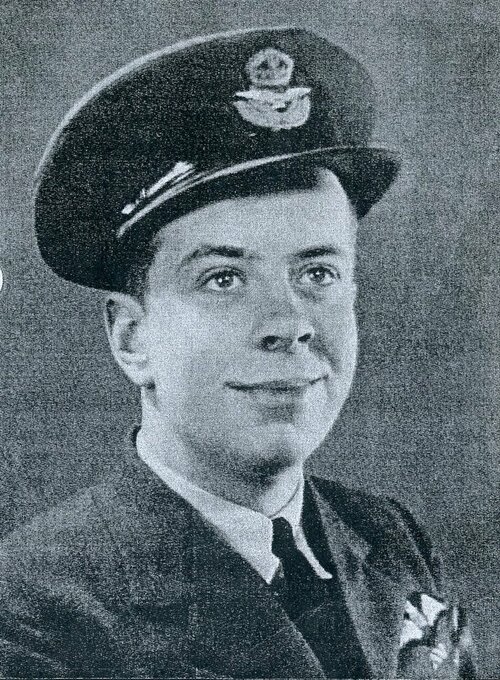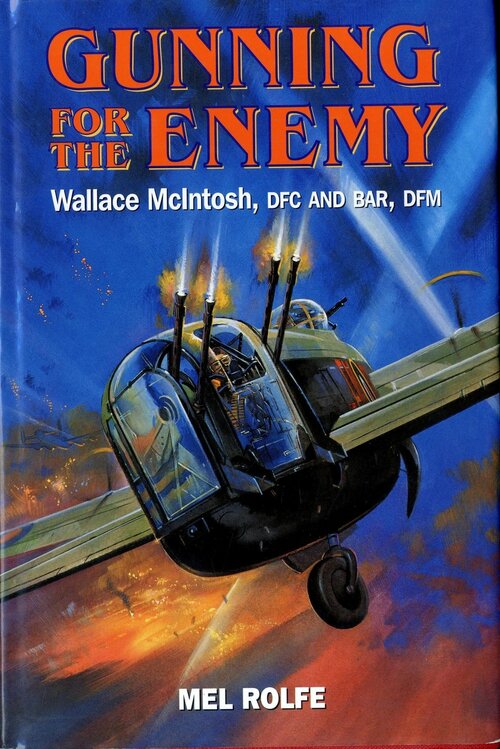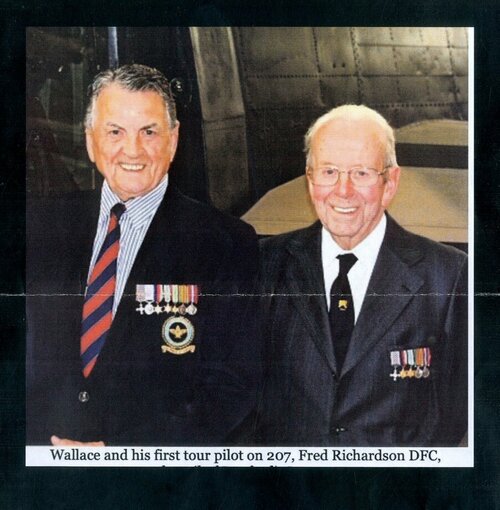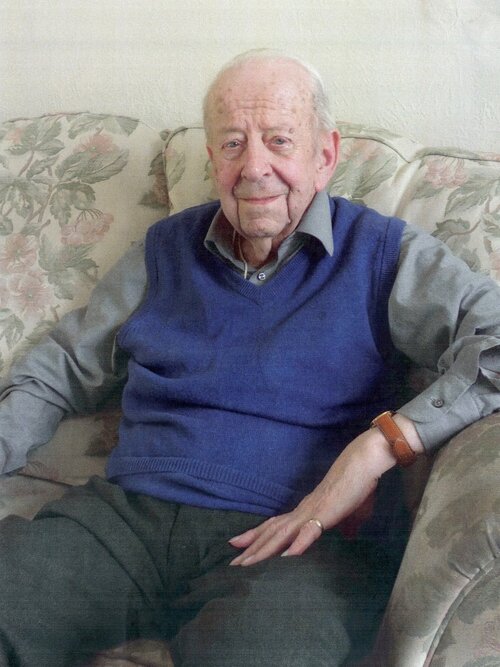Auction: 21003 - Orders, Decorations and Medals
Lot: 546
(x) A 1943 D.F.C. group of five awarded to Pilot Officer F. J. Richardson, Royal Air Force Volunteer Reserve, who Captained the aircraft of the famous Air Gunner Wallace McIntosh
Distinguished Flying Cross, G.VI.R., the reverse officially dated '1943'; 1939-45 Star; Air Crew Europe Star; Defence and War Medals 1939-45, good very fine (5)
D.F.C. London Gazette 19 October 1943, this citation quoted in the Bradford Observer 15 October 1943, states:
'This officer has inspired great confidence in his crew. He has operated against most of the major targets in enemy territory, always displaying the greatest determination and coolness whatever the hazards. On several flights his aircraft has been attacked by enemy fighters, but by skilful flying and excellent co-operation with his gunners he has not only succeeded in saving his aircraft from damage but has enabled his gunners to return accurate fire against the assailants, probably destroying two of them.'
Frederic James Richardson was born at Glusburn, Yorkshire in 1922, the son of a Poultry Farm Manager. He joined the R.A.F. with a friend, Geoffrey Dickinson, in March 1941 going first to Bournemouth, likely R.A.F. Hurn, where he met his future wife and later to Monkton. At this point Richardson was taken aboard the Louis Pasteur and transported first to Canada then to No. '1', British Flying Training School, Texas. Promoted to Sergeant (Pilot) he returned to Britain, in his own words:
'Where do you want to go when you get back to England?' He said, 'It's either Harrogate or Bourneouth.' I said ' I want to go to Harrogate don't I?' so where did they go Bournemouth.'
Returning to Bournemouth Richardson got an aircrew and they were transferred to 29 Officer Training Unit, North Luffenham. It was at this point that he performed his first mission, a leaflet raid over Paris. Moving out to R.A.F. Wigsley Conversion Unit, he picked up another Air Gunner, this being Wallace McIntosh, later D.F.C. and bar, D.F.M., widely believed to be the top sharpshooter in his role. On 14 January 1943 Richardson and his crew were posted to No. 207 Squadron at Langar, Nottingham and it was from here that they would perform most of their missions. His second raid was flown from here, a night bombing run over Nuremberg despite riding with a more experienced pilot this raid still stuck in his mind as a 'hairy' one.
From this point Richardson began to fly regularly with his own crew, their first sortie being against the U-Boat Pens at Lorient. McIntosh noted that after the attack Richardson dived to avoid the enemy fire building up a great deal of speed before levelling out and touched 360 mph over the Bay of Biscay. That raid proved to be the heaviest that Lorient suffered throughout the war. The crew was worked hard throughout 1943 launching an attack on Duisburg on 26 March they then took part in a major attack on Berlin on 27 March. Here they were twice attacked by night fighters which McIntosh and the other gunner Grant Booth finished of. Two days later they returned to Berlin for their tenth sortie, Gunning for the enemy, Wallace McIntosh DFC and Bar, DFM by Mel Rolfe speaks of the toll which the pace and ferocity of the fighting took on the crews, stating:
'I believe that March to May 1943 were the roughest months I can remember. The flak was heavy and the losses were high. You just carried on, night after bloody night, not wanting to hear too much about the statistics, really. It was quite traumatic at that time. In those days we were maybe only putting out eight or nine aircraft for an op because there was a shortage of bombers, so many were being shot down and crews killed. If you lost two that was a hell of a lot. And everyone was so young.'
The constant sorties also took a toll upon the aircraft and on 3 April 1943 during a raid over Essen a mechanical failure sparked an engine fire aboard Richardson's Lancaster. Fortunately he had the presence of mind to quickly launch the aircraft into a steep dive which extinguished the flames. Again attacked by night fighters over La Spezia on 13 April Richardson was able to avoid the enemy fire and get his craft into a position for McIntosh and Booth to open fire, downing yet another fighter. Richardson was remarkably cheerful over the intercom afterwards, 'Okay boys, time for a fag' (IBID).
Not all his crew were entirely impressed by his flying when on 20 April 1943 his bomb aimer Sammy Craig called over the intercom:
'Fred, I'm soaking wet'. Having allowed his skipper a distracted moment to digest this morsel of the bomb aimer's extreme discomfort in the nose of the Lancaster Craig added, plaintively: 'Can you go up a bit?' (IBID)
The low level flying over the Baltic Sea was intended to ensure surprise upon their duel targets, the Settin Shipyards and Rostock's Heinkel factory. After some initial scepticism Richardson agreed to fly slightly higher, not by much though as he recalls when closing on the targets he was playing leapfrog with the electric cables. He could be a terror on the ground as well, as was remembered by most of the pilots of 207 who use to say:
'For Chrissake, get in behind Richardson. Don't go in front of him, the bugger'll catch you up' (IBED)
In June Richardson was informed that all Captain's of Aircraft needed a commission. He wasn't keen to get one believing it would lead to expenses but was told that if he didn't his Radio Operator would become Captain of his aircraft which was too much for the young pilot. He was to be interview by Sir Ralph Cochrane, a worrying prospect made worse by his Group Captain, who disliked volunteers, considering him unsuitable and stating such in his report. Richardson speaks of the interview in his 2016 interview with David Meanwell states:
'And he said, 'How many trips have you done?' I think at that time I'd done about nineteen, said 'Any aiming point photographs?' I said, 'No'. 'Target area?' 'Yes, got one target area one. 'Mmm', he said, 'You've managed so far, I think the group captain's a bloody fool you've got the commission'.'
They continued to fly runs at German and Northern Italian industry, twice landing at Blida, Algeria because the target was too far for them to return to Britain. Richardson's crew also flew in the 16 July Cislago raid, bombing and then machine gunning the power station which fed the North Italian railway network, it was after this raid that they returned to Blida a second time. They were also active during the 'Battle of Hamburg' on 24-25 July, an operation which was to be the last of their tour and which proved every bit as tough as the rest.
Leaving Langer Richardson went on to work as an Instructor for Bomber Command Officer Training Unit, which shortly became Transport Command Officer Training Unit. Promoted Flight Lieutenant on 27 April 1945 he was offered a job with the Royal Air Force after the war but turned it down having heard that the standards were high and just one poor landing was grounds for dismissal. He married just prior to leaving the Air Force, enabling him to do so in uniform, he later obtained his Class 'B' release. Working first for Rustlers Iron Company at his former home in Keighley, Yorkshire he moved to Bingley after the birth for his eldest child in 1950. From Bingley the family moved to London in 1954 where Richardson, after some false starts began work with De La Rue. He retired in 1987 and went on to run two charity shops; sold together with the original, named forwarding letter for his D.F.C., R.A.F. 'Wings' along with a transcript of the 2016 interview, a copy of Gunning for the Enemy, Wallace McIntosh DFC and Bar, DFM by Mel Rolfe, copied London Gazette entries and an extract from the Bedford Observer also with several copied photographs.
Subject to 5% tax on Hammer Price in addition to 20% VAT on Buyer’s Premium.
Sold for
£2,300
Starting price
£950

